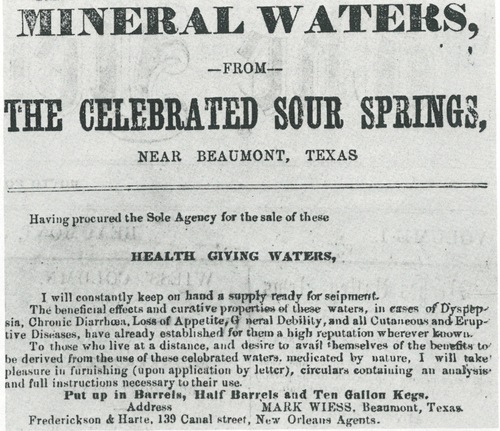.JPG)
Early Bottling Works Provided Early Beaumonters with Beverages
By Judy Linsley
Coca-Cola came to Beaumont not long after Spindletop and soon became a hit. It wasn't the first beverage and bottling firm in Beaumont, however. Back in the nineteenth century, enterprising Beaumonters bottled and sold water from local mineral springs as curative drinks.
In 1873, the Beaumont News-Beacon advertised "Mineral Waters from the Celebrated Sour Springs, near Beaumont, Texas." Mark Wiess, the bottler and distributor, stressed the water's "beneficial effects and curative properties" for a number of digestive and skin diseases, as well as loss of appetite and "general debility." The "sour springs" were the mineral springs near the salt dome where oil would be discovered in 1901.
Park Farm, near Beaumont, supplied the local beverage market with Park Farm Lithia Water in the late 1800s and early 1900s. Lithia water contains lithium salts, used in some medicines today, so it possibly had some curative value.
About 1887, Guilford M. Loomer, formerly in the lumber business, opened the East Texas Bottling Works, which sold "all flavors of soda water, ciders and vinegars." He later included mineral waters, "champagne cider," and wild cherry and orange ciders.
"Crazy Water" was popular around 1900 and was available in drugstores or food markets. It wasn't strictly local but came from the spa town of Mineral Wells, Texas.
The 1909 Beaumont City Directory lists two bottling companies, Coca-Cola and the East Texas Bottling Works. By 1916, the C.R. Tolivar Bottling Works has replaced the East Texas Bottling Works. Coke has expanded its product line to include "Iron Brew," and Tolivar not only manufactures "soda water," it sells liquor, beer, and wine.
By 1929, after Beaumont's second Spindletop oil boom, four bottling companies appear in the directory: Coca Cola Bottling Company, Brandimist Bottling Company, Sabine Nehi Bottling Company, and Union Bottling Works.
Nehi beverages included the popular RC Cola, fruit drinks, and "Par-T-Pak beverages." The original Nehi (knee-high) logo showed a seated woman's legs with the skirt raised to show the stockings up to the knee.
In the early 1930s, Coca-Cola built a beautiful brick building with the distinctive Coca-Cola logo in cast concrete over the main entrance.
In the 1933 directory, the NuGrape Bottling Company and the Uneeda Bottling works joined other Beaumont bottlers, though NuGrape was gone by 1939.
In 1940 a couple of familiar names appear for the first time: Barq's Bottling Works and Dr. Pepper Bottling Company.
Jumping far ahead to 1967, we see national bottlers Coca-Cola, Dr. Pepper, Grapette, Pepsi-Cola, Seven-Up, and RC Cola. Barq's is gone. Uneeda is the only remaining local name, and it is destined to disappear as well.
Today enormous changes have come to the bottling business, mainly the switch to disposable plastic or aluminum containers. Only Coca-Cola and Dr. Pepper appear in the current telephone directory. It's a far cry from the 1800s bottlers of mineral water-but wait! Their legacy survives in the gargantuan business of "spring water" and sports and vitamin drinks, many of which work miracles-if you believe their commercials.
